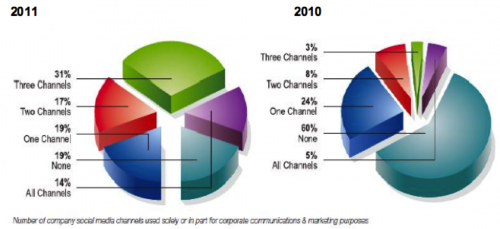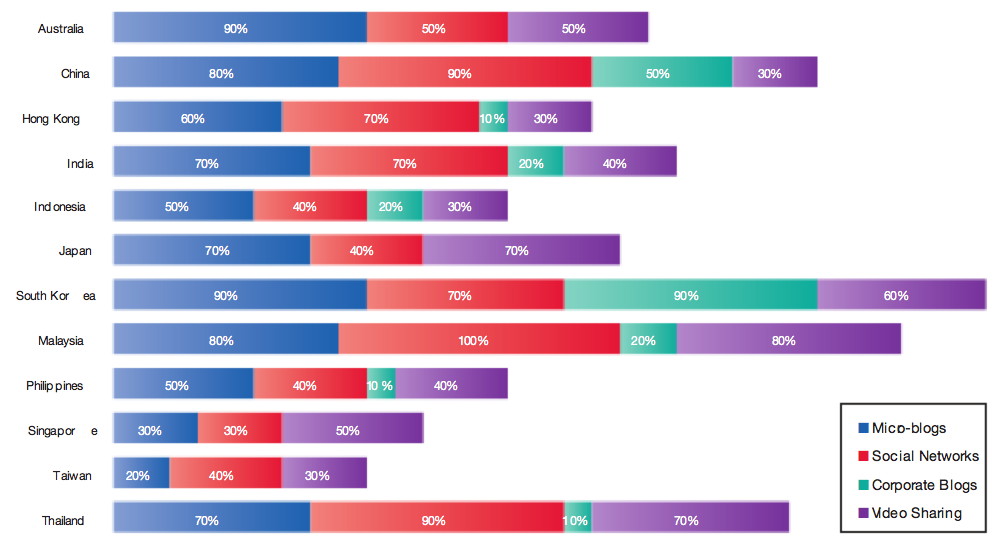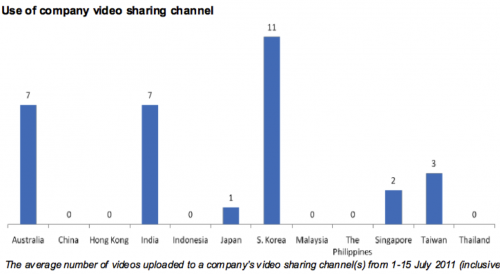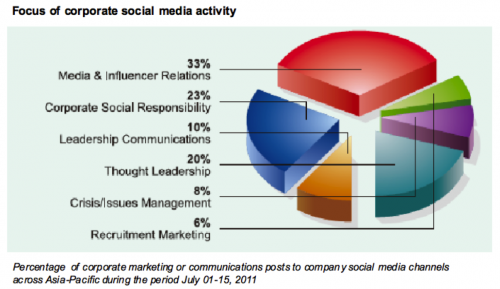Asian brands struggle with social strategy
New research shows that more and more brands in Asia are using social media, but few have adopted a strategic approach. In particular, brands in Asia still seem to view social media as advertising channels, using them sporadically as one-way supports for conventional campaigns, rather than as longer-term relationship channels.
The study, conducted by PR firm Burson Marsteller, found that more than 80% of leading Asian companies now have a branded social media presence, compared to just half that number a year ago. 45% of brands active in social media are present in 3 or more channels – a startling five-fold increase from the previous year:
Worryingly, however, the report also finds that 62% of brands’ social accounts are dormant, with many having been set up for tactical, campaign-based activities. Many show a sudden burst of activity around a specific topic for a short period of time, before turning totally silent. Meanwhile, the majority of the content shared by brands using this approach follows a ‘push’ approach, with many brands simply posting the same content they broadcast through traditional advertising channels.
While it’s important to acknowledge that social media can play an important role in improving the success rate of broader, integrated marketing activities, this purely tactical approach fails to take advantage of the huge opportunities presented by social media. This approach is reminiscent of the mid-90s, when brands rushed to set up an internet presence by sticking print ads onto websites, without taking time to understand the unique potential of the new channel.
As part of a shift to more strategic adoption of social media, it’s important for firms to understand why their audiences use different social media, and identify ways their brands can become a meaningful part of those audiences’ social experiences. Similarly, brands must also set specific objectives social media, mapping out the ways in which activities will deliver value to their business over time.
Tailoring your brand’s approach for different countries is also important, as different cultures use social media to differing degrees and in different ways. Reassuringly, the BM study found that brands in South Korea and China were the most active in social channels, mirroring audience adoption of social media in those markets. They found 90% of South Korean firms have adopted micro-blogging, paralleling Koreans’ accelerating uptake of services like Twitter. A similar number of Korean brands maintain more traditional corporate blogs too, in line with North Asia’s continuing love affair with longer-form social content.
80% of Chinese firms use micro-blogs too, with Sina Weibo and Tencent Weibo attracting the lion’s share of attention. However, social networks still dominate Chinese brands’ approach to social media, with 90% having a social networking presence on sites like Renren. Despite Chinese netizens’ prolific consumption of online video though, the report suggests that merely 3 brands out of every 10 engage in video-sharing activities:
Across Asia in general, Social networks are the preferred social channel for branded activity. The ability to share longer-form content, create customisable tabs, and post photo galleries mean they offer a greater degree of flexibility to brands wishing to create multifaceted relationships with their audiences.
However, we’re noticing that an increasing number of brands supplement these activities with micro-blogging, taking advantage of opportunities to share smaller, more focused updates in real-time with their followers – especially those on the go.
Despite this surge of activity within social media, however, the level of integration back to corporate websites remains disappointing. BM speculates that this may be the result of residual concerns around public ‘loss of face’ – a fear that any mistakes they make will be visible to the world at large.
The limited use of video was another finding that stood out for us. More so than tweets or status updates, videos offer a way to share engaging and compelling stories in easily consumed servings. Our understanding is that the need to create regular video content is likely the main reason brands fail to make more use of video in their activities:
Perhaps surprisingly, the study also indicates that relatively fewer Asian companies use blogs to communicate with corporate audiences, preferring to focus the majority of their social activities on more consumer-oriented audiences:
However, brands are making use of other social channels for corporate marketing initiatives. Top of the list are activities focused on establishing and maintaining media and influencer relations:
We predict that Asian brands will make increasing use of social channels for B2B activities in 2012, harnessing a growing number of professionally oriented platforms and networks in the region.
As this momentum accelerates, however, it’s important for brands to avoid approaching social platforms in silos. Brands need to harness social networks for what they are – webs of interconnected relationships – and adapt their use of each channel according to the needs of different audiences and objectives.
See the full Burson Marsteller report here.





